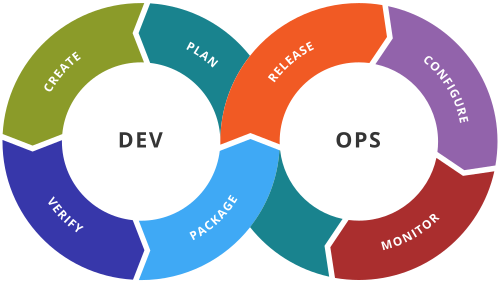Difference Between DevOps and SysAdmin
The phrase software delivery lifecycle (SDLC), as the name suggests, refers to the multi-step process starting from the source code, through software testing, packaging, and beta, and finally to deployment and production. The entire process is no single man’s job; in fact, it is a collective effort that requires collaboration from developers and IT operations alike. This is where the term DevOps comes from. Businesses have recognized that the practice of system administration has evolved into something fundamentally different. That is why organizations started adopting the DevOps practice because they understood that websites could be better run when deployment and operations were done in collaboration. Some even believe that DevOps is a logical evolution of having sysadmins and developers participating in an Agile development cycle together and using Agile methodologies for system work.

What is DevOps?
DevOps is not exactly a role, but more like a buzzword used a lot around these days. DevOps is a culture, a world wherein developers, Quality Assurance (QA), and system administrators work more closely together than in traditional work environments. DevOps is a combination of ideas, practices and tools that increase an organization’s ability to deliver products with utmost efficiency. The DevOps practice is focused on making the SDLC as smooth and effortless as possible. By unifying development and operations, it aims to eliminate the organizational silos that prevent companies from experimenting and trying new things, thereby making them more competitive as more effective features appear more frequently, bugs are rectified quickly, and even minor hurdles are quickly alleviated. It encourages a culture of innovation that promotes automation across various processes within an organization, so that development and operations teams can work together to build, test and deploy software faster.

What is SysAdmin?
A system administrator, or sysadmin, is also a part of the development team throughout the SDLC and is vaguely similar to a DevOps engineer in practice but a little complex. In fact, the role of a system admin is one of the complex and diverse roles within an organization. Although, a system admin does not play a more involved role like a DevOps engineer, he has a fundamental role to play. A system admin role is narrowly focused toward configuration and functioning of computer systems and servers, and he makes sure the systems are up and running at all times. As opposed to DevOps, system administrators do not usually involve directly in the software development process, but is tasked with product configuration, monitoring solutions, troubleshooting, and basically everything that is required to run the software. System administrators are actually the brains behind the whole infrastructure to run the software. As a sysadmin, your main job is to make sure that the production environment is up and running, and to deal with Service Level Agreements (SLAs).
Difference between DevOps and SysAdmin
Job
– DevOps is a combination of ideas, practices and tools that increase an organization’s ability to deliver products with utmost efficiency. The job of a DevOps engineer is to promote automation across various processes within an organization, so that development and operations teams could work together to build, test and deploy software faster. DevOps is more focused on collaboration between the teams. A system administrator is also a part of the development team but is more focused on configuration and maintenance of computer systems and servers.
Role
– DevOps is not exactly a role, but a world where developers, Quality Assurance (QA), and system administrators work more closely together than in traditional work environments. The DevOps practice is focused on making the SDLC as smooth and effortless as possible. The goal is to merge everyday tasks involved in the software development process into a single, continuous set of processes. The primary responsibility of a sysadmin is to maintain, manage and upgrade an organization’s software, hardware and networks. Other responsibilities include making sure that the production environment is up and running, and to deal with Service Level Agreements (SLAs).
Focus
– The aim of a DevOps engineer is to make sure every team involved in the SDLC work and collaborate together at every stage, starting from the source code, through software testing, packaging, and beta, and finally to deployment and production. The focus is to make the SDLC as smooth and effortless as possible. A sysadmin, on the other hand, is narrowly focused on installation and configuration of new software and hardware, analysis of systems logs, troubleshooting problems, management and maintenance of computers servers, solving queries of users, maintaining security, and more.
DevOps vs. SysAdmin: Comparison Chart

Summary
DevOps is a logical evolution of the software development methodology known as “Agile” and the practices called “continuous delivery.” Although, DevOps is more about collaboration between the development, operations and Quality Assurance teams, it does not stop with collaboration. It can be useful up and down the entire organizational chain. The idea is to break down the organizational barriers between development and operations, thereby making the SDLC as smooth and effortless as possible. A system admin does not play a much involved role like a DevOps engineer, but his role is not to be underestimated. A SysAdmin’s main job is to make sure the production environment is up and running all the time. In fact, a SysAdmin is the brains behind the whole infrastructure to run the software.
- Difference Between Caucus and Primary - June 18, 2024
- Difference Between PPO and POS - May 30, 2024
- Difference Between RFID and NFC - May 28, 2024
Search DifferenceBetween.net :
Leave a Response
References :
[0]Rankin, Kyle. DevOps Troubleshooting: Linux Server Best Practices. Massachusetts, United States: Addison-Wesley, 2012. Print
[1]Limoncelli, Thomas A. et al. The Practice of Cloud System Administration: DevOps and SRE Practices for Web Services, Volume 2. Massachusetts, United States: Addison-Wesley, 2014. Print
[2]Limoncelli, Thomas A. et al. The Practice of System and Network Administration: Volume 1: DevOps and Other Best Practices for Enterprise IT. Massachusetts, United States: Addison-Wesley, 2014. Print
[3]Davis, Jennifer and Ryn Daniels. Effective DevOps: Building a Culture of Collaboration, Affinity, and Tooling at Scale. California, United States: O'Reilly Media, 2016. Print
[4]Image credit: https://upload.wikimedia.org/wikipedia/commons/thumb/0/05/Devops-toolchain.svg/500px-Devops-toolchain.svg.png
[5]Image credit: https://pixabay.com/illustrations/administrator-sysadmin-sysop-1188494/
